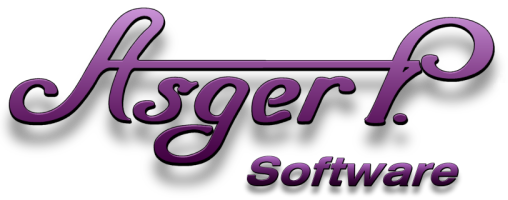

Here is an alphabetic list of the tools that comes with QLaunch and below the
list there is description and help to each tool. How to add the tool buttons to
QLaunch is described on the QLaunch page.
The help below is not organized alphabetic, but after how much I personally use
each tool and when they were created. The images to the left of each item in the list are links to the right help and the same
goes for the Learn more link at the end of each items text.
The alphabetic list of tools is the same on both the Qlaunch Tools 1 and 2 page, but
the explanation below the list is different, Qlaunch Tools 2 contains the latest
tools added.
Alarm: Is a Simple Alarm Clock or an advanced Kitchen Timer. That can give you daily alarms, count downs alarms or measure time like a stop watch. Learn more.
Alphabetizer A2Z: Is a program that can take a piece of text and then sort all the words or just the lines alphabetically. Learn more.
Break Lines: Break all the text lines in the clipboard, at a word separator closest to 65 characters or closest to the line length you have chosen. Learn more.
Break Comment Lines: Break the text lines in the clipboard, at 65 characters or at the number you choose and then it inserts a > sign in front of each line. Learn more.
Clean Clipboard: Cleans the text in the clipboard for all formatting encodings and leaves only simple text in the clipboard. Learn more.
File Template: File Template can use any of your files as a template, for creating a new file, in a predefined location and then open it with the right program. Learn more.
File Time: File Time can change creation time, modification time and last access time or all on any writeable file on your computer. Learn more.
Folder Menu: Folder Menu can give you a view of a folder in a drop down menu, what is shown in the drop down menu can be filtered and sorted in many different ways. Learn more.
Icon To Pngs: Icon To Png Files. Let you extract all or just selected images from any icon and save them as 32bit Png files, with just a few clicks. Learn more.
Image(s) To Icons(s): Image(s) To Icons(s) Let you convert image(s) to icons, just by dropping on the app or button. The resulting icon can contain as many as 10 different image sizes. Learn more.
Magnify and Pick: Magnify and Pick can magnify any part of your screen up to 48 times the normal size. It can pick the color value of any pixel and it can click any point. Learn more.
Minimize All: Minimize all open windows that can be minimized, leaving you with a clean and unobstructed view to the desktop.
Picture: Picture, is a simple tool for showing one picture in the size and at the position according to your whishes. Learn more.
Print Screen Catcher: Print Screen Catcher, works in combination with the keyboards Print Screen key, by monitoring the system and save any catched images to png files. Learn more.
Screen Camera: Screen Camera gives you a view finder frame, that you can drag to any position on the screen and take a picture + much more. Learn more.
Sticker: Sticker, helps you take notes with the smallest effort possible, Click write and return to your work. No need to concern about saving or closing. Learn more.
Web Image: Is a small program that will help you resize Crop and Compress you digital images so that they are more suitable for use in mails and on the internet. Learn more.
![]() View the Qlaunch Quick Tour Video
View the Qlaunch Quick Tour Video
![]()
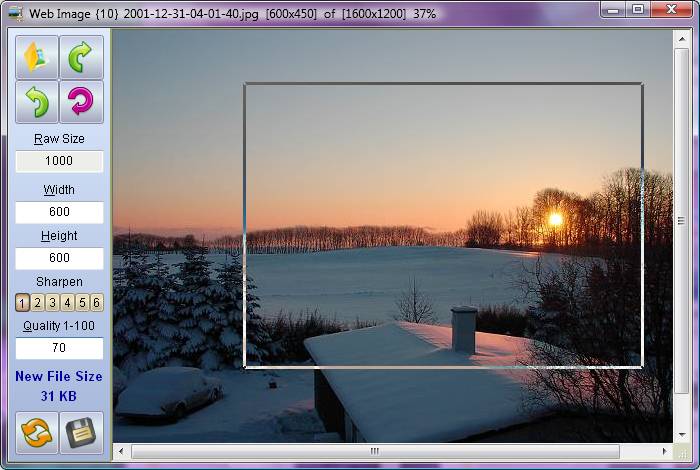
Web Image is a very simple and yet very useful program, that will help you manage those huge digital photos from your digital camera and phone. Digital photos today are so big, that they are a pain to browse, to email or to upload to the social network, forums etc. And that is where Web Image will ease your "pain".
When using Web Image you can downsize your images, you can crop your images, you can sharpen your images and you can determine how hard you want to compress your images when saving them, you can even see the size of the new file before you save it. And everything is WYSIWYG ( What You See Is What You Get ). You can work one file at a time or you can do a whole bunch files in one go automatically.
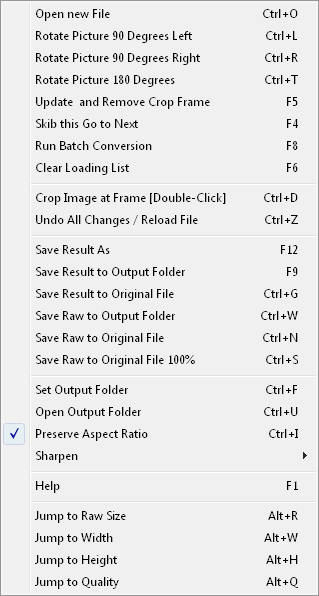
When you start Web Image, this button is the only one that is active, so you can either click it or you can drop one or more files on the program surface, both ways are valid for opening new files.
These buttons are Rotate 90 Left, Rotate 90 Right and Rotate 180 degrees. The reason they are in the program, is so that you can correct the image angle, in case held your camera in a different angle then horizontal, when you took the picture. If your camera are of the advanced kind and it fill the EXIF data in the jpg file, Web Image will rotate the image automatically.
Next we have the Raw Size edit field, this is where you set the size of the image that the program will hold in memory behind the scene. The reason for this is that when you have these very large digital pictures, it takes time to apply sharpening and it takes time to produce a compression preview. These functions does work a lot faster on smaller images. Raw Size is default set to 1200, this means that the smallest side of the picture will be set to 1200 and the other will be larger. Every time you change this number You will have to press Ctrl+Z in order to do a full reload of the image.
Are max values, this means that which ever side first meet its max will determine the size of the image, unless you turn of Preserve Aspect Ratio. If you do that the image will be resized to the width and height that is set in these edit fields. Every time you change these numbers you will have to press F5, Enter or click the update button.
As you can see there are six sharpen buttons, each one representing a level of sharpening that will be applied during image update. If none of the buttons are down, no sharpening will be applied. Sharpening affects different kind of images very differently, so be careful not to set it to high when doing batch conversion. Update is automatically called when you change the sharpen setting.
This field determine the quality of the final JPEG file. A high number means better picture quality, but it also means that the file is larger, because when you compress a JPEG file, you loose some quality and the more you compress, the more quality you loose. This value is default set to 70 and in most pictures you cant see the loss of 30% at all, in some pictures you can even go as low as 30 without seeing the flaws.
This label tells you the size of the new file, as a result of the Width, Height and Quality, you have chosen. Here you can see right away the effect your choices have on the final file size.
that will be applied during image update. If none of the buttons are down, no sharpening will be applied. Sharpening affects different kind of images very differently, so be careful.
If you click this button, its the same as pressing F12 and you will see a save as dialog, where you can browse for a location and type in a new filename. You can also hold down Ctrl while you click the button, That will be the same as pressing F9 and then the file will be saved to the Output Folder with the same name as the original file (no questions asked).

These four functions are a little special, they are special because they do not
ask questions and there is no undo, so be careful:
The first one save the result you see in Web Image to the original file, in other
words it replace the original file with the new one.
The second save the Raw Image (the image behind the scene) to the Output Folder
with the same name as the original file, the file is saved with the quality
chosen by you.
The third one saves the Raw Image to the original
filename with the quality you have chosen and the last one does the same but
with a 100% quality (best quality). You can see more about these special save
functions in the Batch Conversion section
Output Folder is one of the reasons why Web Image is so easy to work with. The output folder is where all the files are saved when you do the F9 save or you are doing a batch conversion. You can change the folder by using the popup menu or by pressing Ctrl+F.
Cropping: is very easy with Web Image
just press left mouse button down in one place then drag the mouse while you hold down
the left mouse button. A Frame will be drawn around the area you are marking. When the
frame have the size you want you just let go of the left mouse button. You can check the
top image to see what the frame looks like.
Now that you have a selected area, you can make that area become the whole picture, by
double clicking on the image or you can use the keyboard combination
Ctrl+D.
A crop is always performed with the original image as the source, in order to ensure
the best quality. This also means that if you want to redo your crop, you will have to
reload the image using Ctrl+Z, before you can do that.
To remove the crop frame just update the image.
Please note: The frame can not be moved or resized, but you can just make a new one,
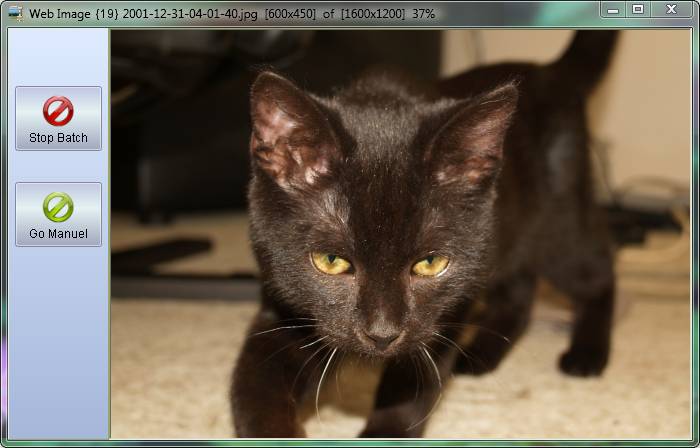
Batch Conversion is when you modify a batch, group or bunch of files at one time.
Web Image have two kind of Batch Conversion modes, one is full automatic and one
is manual, The image here above with my cat when it was little show Web Image in
full automatic batch mode. This is what you will see if you drop a bunch of
files on a Web Image button on QLaunch, while you hold down the Ctrl key
or when you have files in the loading list .
Yes, only two buttons, one that will abort the batch conversion and close
Web Image, that is the Stop Batch. The
Go Manual button will stop only the automatic part of the batch
conversion, but keep Web Image open and it will also leave all
the files you dropped on the button, in the loading list.
When running the full automatic batch conversion, each file will be resized sharpened and compressed according to the settings you have chosen. When that is done the new file will be saved to the Output Folder. After the save Web Image load the next file and do it all over again.
Manual batch conversion: Is actually the normal state of Web Image and you will see that if you drop or open a bunch of files into Web Image. The file or files you open in Web Image is actually added to a loading list and only the first file in that list is opened. When you do a save, the next file in the list is loaded automatically.
Dropping files accumulate! This means that you can have
Web Image
open and then collect files from different folders, by dropping them on the
program, you can also use the open file(s) dialog more then one time.
You
can then keep track on how many files that are in the list, by checking the
number in the curly brackets {10}, in the Web Image title bar,
the number in the brackets does not include the file that is already open.
The only way to avoid accumulating files in the load list is if you load one
file at a time, because if the list is empty the first file opened or dropped
is always loaded into view.
| Web Image Shortcuts | |
| Open new File(s) | Ctrl + O |
| Rotate Picture 90 Degrees Left | Ctrl + L |
| Rotate Picture 90 Degrees Right | Ctrl + R |
| Rotate Picture 180 Degrees | Ctrl + T |
| Update and Remove Crop Frame | F5 or Enter |
| Skip this File and go to Next | F4 |
| Run Batch Conversion | F8 |
| Clear Loading List | F6 |
| Crop Image at Frame | Ctrl + D or Double-Click |
| Undo All Changes / Reload File | Ctrl + Z |
| Save Result As | F12 |
| Save Result to Output Folder | F9 |
| Save Result to Original File | Ctrl + G |
| Save Raw to Output Folder | Ctrl + W |
| Save Raw to Original File | Ctrl + N |
| Save Raw to Original File 100% | Ctrl + S |
| Set Output Folder | Ctrl + F |
| Open Output Folder | Ctrl + U |
| Preserve Aspect Ratio | Ctrl + I |
| Sharpen | Ctrl + 0 to Ctrl + 6 |
| Jump to Raw Size | Alt + R |
| Jump to Width | Alt + W |
| Jump to Height | Alt + H |
| Jump to Quality | Alt + Q |
With this tool you can make an image into a real windows icon in just a couple
of clicks.
You can use Png, Bmp, Jpg and Gif files as the source. You can use one image or
you can use many different sized images as the source.
Let me start with a few words about the windows icon. Icons are files that can contain from 1 to 6500 images, but it usually it holds from 1 to 20 images. Modern icons for windows XP and forward hold images in 32bit colors with alpha transparency. On XP the max icon size is 48x48 but on Vista, 7 & 8 the max size is 256x256.
Image To Icon create all icons in full 32bit colors and each
icon can hold from 1 to 10 sizes.
If you look to the top of the above image you can see a row of check boxes, this is where you decide which image sizes you want to be present in your icon. And it is also where you decide if the 256x256 image should be PNG compressed. Applying PNG compression to the 256x256 image make the icon shrink to half the size. When you select or unselect these checkboxes the images below will reflect you choice right away.
I you look at the text below the images you will see that the top line shows the size of the image and the line below it shows the color resolution and it also shows if the image will be PBG compressed. At the first image in this example you also see two ** stars, those stars tell you that this image is not resized, it is the original image that is showing, Image sizes that do not have those stars, are created by Image To Icon.
Here to the right you see the Popup Menu you get if you right click on one of the images. The first four items are different levels of sharpening that you can apply to the images, you can apply each sharpener as many times as you want. There is no undo for each sharpener, but you can reload each image, by selecting Reload this Image or you can Reload All images by clicking that item.
Image To Icon can use an image from the Clipboard as the source of an icon as well as one or more dropped files, or you can find a file or several files on the disk, by clicking the Open button. All images in Icons are square, so if the image you load isn't square, the picture will be padded with transparent pixels until it become square.
Save and Save As Save As behaves exactly as you are used to from other programs, it opens a save as dialog where you can browse for a location and write a filename. Save on the other hand is a little special, it saves the file to the directory shown in the Output Dir edit field and it uses the name you see in the Output Name edit field. The save function will not overwrite any existing file, it will instead insert a number in parentheses just like windows does e.g. FileName(1).ico.
Auto Conversion with Image To Icon: You can drop a set of different sized images onto the Image To Icon button while you hold down the Ctrl key, this will put the dropped images into one icon as different images. You can also drop just one image while holding down Ctrl, that will convert the image into a single image icon file.
Batch Conversion with Image To Icon:
You can drop a bunch of images on the
Image To Icon button, while you hold down the Shift key.
Then Images To Icons create a new icon for each image you dropped
on the button.
Each icon will contain as many different image sizes as you have set up in the
Button Properties dialog. the setting that determine the number
of image is the Icon formats line, the numbers you see on the picture are meant
as an example, but they are also icon format recommended by Microsoft.
You can actually have any size between 1 an 256, not that an icon of 1x1 pixel
make much sense.
The icons created during the batch conversion is saved to the Destination
folder. Whether or not PNG compression will be used on the 256x256 image is
determined by the checkbox at the bottom.
Remarks: When you create your image(s) for an icon it is always better to create large images, then it is to create small images. Image To Icon can only down size images with very high quality, up sizing always loose quality. So if you only want to hand edit one image, do it to an image equal to the largest image size you want in your icon.
This app lets you View the contents of icons and it lets you extract each image separately, one by one or all at once and save them as 32 bit PNG files.
When you open ONE file, by drag and drop or using file open,
Icons To Pngs automatically search the directory for other
icons and add them to an internal load list. This list can be navigated in three
ways:
1. Using the two arrow buttons.
2. Pressing F5 or Enter for forward and F4 or Ctrl+Backspace for back.
3. Use the mouse scroll wheel.
If you open or drop more then one file Icons To Pngs will only add those files to the load list and not search for any files in the directory.
If you take a look at the window title bar you will see two numbers [282][201] the first tells you how may files there are in the load list and the second tells you the number of the file that is open at the moment. After the numbers you see the name of the file, followed another number [13] this number tells you how many images there are in the icon that is currently open.
Below each image you see two lines of text the top line shows the size of the image and the line below it, shows the color resolution, and it also shows if the image is PBG compressed.
The white frame around the text means that this one is selected. You select an image by clicking it an you deselect by clicking it again.
When you do any kind of save the file(s) are saved with the name you see in the Output Name field + color resolution + size + . ico if that file exist there is added (1) or (2) after the size until a unique name is found. So clicking Save Selected [Ctrl+T] on the above would result in one file named "PcNet XP 64.ico" and the file would be save to: "C:\Users\UserNAme\Pictures\" .
The text in the Output Name changes every time a new file is loaded, where as the text in the Output Dir remains the same until you replace it by browsing for a new directory or by writing a new location.
NOTE: When QLaunch is installed, the Icon To Png
tool, will available in the Open With menu for icon files, as
QLaunch Icon Viewer and Converter, but please note that this
app will only work if QLaunch is running at the same time.
In order to associate QLaunch Icon Viewer and Converter right
click an icon file somewhere on you PC and find the Open With
sub menu, You should see a menu that looks something like the image at the left
here below. Click Chose Default Program then you should see a
dialog that looks something like the image to the right, select QLaunch
Icon Viewer and Converter and click OK. When that is done you can open
icon files simply by double clicking them.
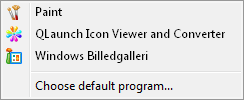
|

|
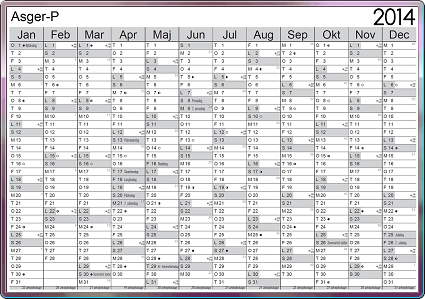
I got tired of looking for my year calendar on the desk among my papers, so I
made this little app to QLaunch and I got a calendar picture on the web. Now it
never takes more then 2 seconds to find the calendar.
The Picture can of
course be used for any image as long as it is either a png,
jpg, bmp, gif, emf
or wmf file.
You can drop an image file on the window and it
will open the file, you can also use Ctrl+O, you can
right-click and chose Open Image File in the popup or you can
paste an image from the clipboard, this means you can use the
QLaunch Screen Camera to capture a part
of the screen then and then paste it into Picture.
When you open a new image file, it is made as big as possible.
This means that the new image will
either be the full original size or the maximum size possible on your screen.
You can resize the image using Scroll up and down or
Ctrl + Scroll up and
down. Please note that Picture
can not be made bigger then the screen and Picture will never
show scroll bars.
Picture will always resize the image to fit the size
you have chosen.
If you are using a large image you can improve the loading time, by saving the
image to a new name. When you save the image to a new file, the new file will match what you see on the
screen and typically be a lost smaller then a modern digital images.
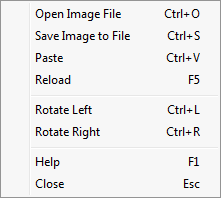
Here to the right you can see an image of the
Picture popup menu, as you can see there is a couple of items
we haven't covered yet. Reload will go back to the initial size
of the image.
Rotate Right and Rotate Left will rotate the
image 90 degrees to either side. If you want to keep such a rotation you will
have to save the image to a file.
Last Updated: Jun-28-2022 © Copyright 2003-2022 Asger-P